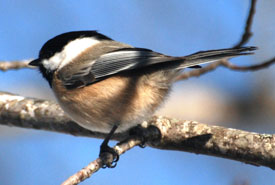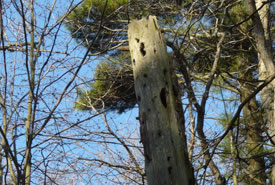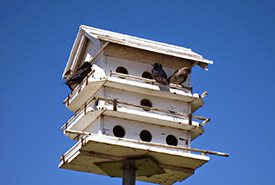Build a chickadee nest tube

Black-capped chickadee (Photo by Paul Turbitt)
Building a nest tube is a great way to provide shelter for cavity-dwelling backyard birds. Learn how to build a simple nest tube, below.
Watch this instructional video
Materials and tools
- 4" diameter, thin-walled PVC
- Galvinized wire
- 3/8” eye screws
- Two 4" PVC caps per tube
- PVC glue
- Duct tape
- Recycled newspapers or natural bedding material
- Electric drill
- 3 cm drill bit
- Dremel tool and sandpaper
- A rod to smooth down drill holes
- Sharpie marker
- Measuring tape
- Vaseline
Steps
- Trim the PVC tube to 33 centimetres in length.
- Eight centimetres from one end, cut a three-centimetre entrance hole with the circular drill bit.
- Use the dremel tool or sandpaper to smooth the entrance hole, but avoid enlarging it.
- Use sandpaper to rough up the interior of the tube.
- Use the small drill bit to drill three to 12 ventilation holes above the entrance hole.
- Smooth the ragged edges of the holes with sandpaper.
- Using the same small drill bit, drill six to eight drainage holes on the PVC cap.
- Apply PVC glue to the inside of the PVC cap with the drainage holes, and put the cap on the bottom of the tube.
- Screw on an eye screw on both sides of the tube, just above the ventilation holes.
- Attach a galvinized wire to the eye screws so the tube can be hung.
- From the top of the tube, fill with bedding.
- Smear vaseline on the tube where the top cap covers it.
- Put the top cap on and hang nest tube outside.
Which birds use nest tube

Dead standing tree cavity (Photo by Bernt Solymar)
Not all birds nest in cavities, so nest tubes are meant to provide shelter for cavity-dwelling birds (there are approximately 50 species in Canada). Common backyard birds that may use nest boxes include:
- black-capped chickadee
- tree swallow
- house wren
- red-breasted nuthatch
With habitat fragmentation and urban development, there are fewer intact forests, woodlands and other natural habitats than there once were. There is also more competition for trees with suitable nest holes between bird species and with mammals. Dying trees or snags are routinely removed because people are unaware of the habitat they provide. By setting up a nest tube, you can help provide more nesting sites and in turn potentially help bolster a declining bird population.
Where to place your nest tube
Different bird species have preferences for their nesting habitats as well. Determine what birds your yard and the surrounding plants support.
Nestwatch provides a good summary of habitat requirements, including optimal height to place the tube, entrance hole size and spacing between tubes.

Multi-suite bird house on Pelee Island, ON (Photo by Wendy Ho/NCC staff)




